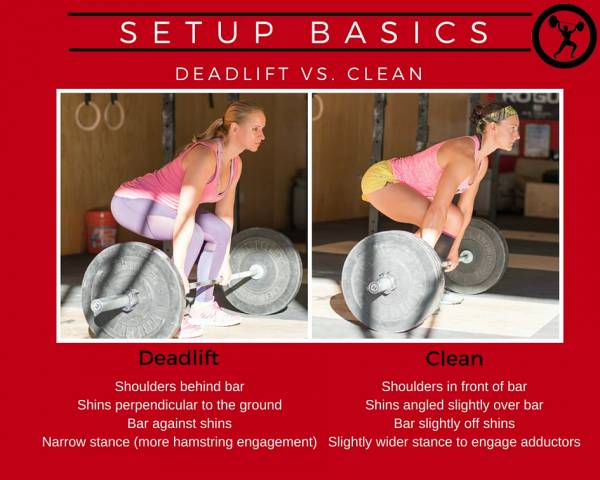There has been much back-and-forth debate on whether the setup for deadlift and clean are different. The truth is, they are.
Although both movements bring the bar to the hip, they arrive there in a different manner. Because the start position sets the stage for the rest of the movement, it is clear that the start position must be different for the deadlift and clean.
Let’s begin by taking a look at the fundamental differences between the deadlift movement and the clean movement.
There has been much back-and-forth debate on whether the setup for deadlift and clean are different. The truth is, they are.
Although both movements bring the bar to the hip, they arrive there in a different manner. Because the start position sets the stage for the rest of the movement, it is clear that the start position must be different for the deadlift and clean.
Let’s begin by taking a look at the fundamental differences between the deadlift movement and the clean movement.
Small changes in foot and shoulder position (pictured above during the setup for the clean) make a big difference.
The Deadlift
The deadlift involves moving heavy weight from the ground until the hips and knees are extended. The height of the bar at the top of the lift will vary depending on arm and leg length, as well as placement of the feet.
“In the deadlift setup, the lifter must find the position where there is the most tension on the hamstrings.”
A sumo position shortens the distance of the lift by moving the feet out wider. In this article, we will not discuss the sumo deadlift.
Rather, we will discuss the conventional deadlift, where the feet are placed almost directly below the hips.
The deadlift is not usually considered an explosive lift, relative to the clean. Although seeing Benni Magnusson below, we might argue about the explosiveness of the deadlift.
The Clean
The goal of the clean is to get the bar up to shoulder level. The first pull brings the bar to the hips. As the lifter brings the bar upward, she will first bend the knees to move the bar out of the way and then re-bend the knees to get into the power position – a jumping position enabling you to explode upward as high as possible to bring the bar up as high as possible.
“The feet are below the hips, but sometimes are slightly wider as the lifter will be torquing the inner thighs.”
Therefore, at the hips, the clean looks different from the deadlift. The lifter has more knee bend due to a need to be in the power position. Danny Carmago, a well-respected Olympic lifting competitor and coach, narrates the clean in the video below.
The Setup
As each of these lifts are brought to the hips differently, it is likely there are some incongruencies in setup. Let’s walk through these:
The Feet:
- Deadlift: Most often the lifter is barefoot or wearing minimal shoes. The feet are placed directly below the hips.
- Clean: The lifter wears Olympic lifting shoes, which place the foot on an incline. The feet are below the hips, but sometimes are slightly wider as the lifter will be torquing the inner thighs.
The Legs:
- Deadlift: In the deadlift setup, the lifter must find the position where there is the most tension on the hamstrings. The bar is right against the shins, and the shins are perpendicular to the ground.
- Clean: There is tension in the hamstrings, but also in the abductor muscles. The hips might be slightly lower than in the deadlift. The bar is slightly in front of the legs. The shins are slightly angled forward toward the bar.
The Shoulders:
- Deadlift: The shoulders are behind the plane of the bar. It is almost as if the lifter is falling backward as he or she grabs the bar.
- Clean: The shoulders are in front of the plane of the bar.

Summary
Training cleans and deadlifts at the same time can be difficult. For athletes wanting to train both lifts, I recommend dedicating a good amount of time to each lift exclusively before working on the other. For example, you could spend eight to ten weeks working on Olympic lifts and then switch to a cycle of deadlifts.
It is difficult for most beginners to master the nuances of performing both these lifts, and moving from one to the next can make it even more difficult.
Both of these movements are excellent for developing hip power and strength, so take the time to perfect the setup and learn the technicalities of each movement.
Further Reading:
- Cleaning Up Your Dirty Clean: It’s All About Technique
- Video: Learn the Most Difficult Phase of the Clean
- 15 Practical Strategies to Increase Your Deadlift Max






